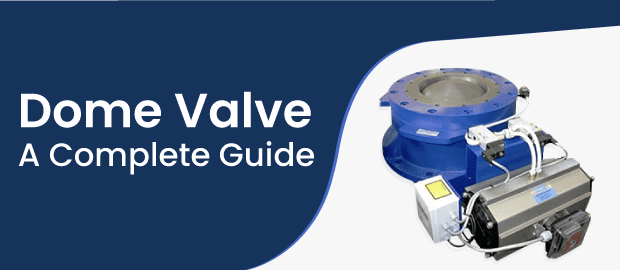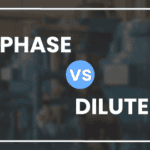Moving on from our previous post on which is better dense phase or dilute phase conveying systems, let’s look at the dome valve, which is an essential component for the operational efficiency of many material handling systems.
There are different types of valves used in pneumatic conveying systems such as dome, cone, plate, flap, etc. Among these, the dome valve is widely used throughout different industries because of its simple design, ease of operation and proven performance. It is also highly efficient and low in maintenance. Thus, let’s check out what a dome valve is and its many benefits along with the dome valve working principle.
Learn How Dome Valves Can Revolutionize Your Industry
A] What is a Dome Valve?
As a power-operated valve, Dome valves are high-pressure valves that have the unique ability to open and close with a pressure-tight seal. They come with a unique inflatable sealing mechanism which makes them safe & reliable and provides greater control. Also, irrespective of the application – abrasive, toxic, friable or hazardous – dome valves offer high performance and is capable of returning over one million maintenance-free cycles.
- Its simple design ensures seamless full bore material flow without any obstruction.
- Thanks to its inflatable sealing mechanism, it provides a dust-free environment and saves energy.
- Its unique dome shape helps cut through the moving or static material, ensuring an airtight seal which makes it more efficient.
- It includes no moving wear parts, offers faster closing performance, and has a long operating life compared to other types of valves.
- Also, for the dome valve, a mere quarter turn is sufficient to move from fully closed to a fully open position.
*Features and Technical Specifications of Dome Valve
- Various MOC options for the body & dome are available such as cast iron CI A48, carbon steel WCB A 216, construction steel, stainless steel (SS 04, 316, 316 L) , haste alloy etc.
- It can handle a nominal pressure of 10 bar (g). However, designs for pressures up to 42 bar (g) can also be provided.
- It can handle a material temperature range from 200 degrees up to 350 degrees Celsius.
- The valves are operated through either Pneumatic rotary actuator, pneumatic linear cylinder or Hydraulic actuator.
- Provisions of limit switches, proximity sensors as well as top/bottom adaptors.
- It comes with the water-cooling feature for maximum design withstand-ability up to 350 degrees. This helps enhance the life of the pneumatic seal and other rubber parts.
Optional equipment: Solenoid valves, pressure switches, pressure gauges, NEMA/ IP specific rating enclosures.
*Dome Valves Are Used For
Dome valves are used throughout a wide range of industries and can handle materials such as:
- Ash
- Alumina
- Chemicals
- Hazardous Materials
- Minerals
- Ores
- Sand
- Toxic Materials
- Zinc
- Food
- Additives
- Power
- Cement
- Steel
- Highly Abrasive Materials like various powders and granules
B] Dome Valve Working Principle
As mentioned above, Dome Valve is a pressure-tight, power-operated valve for application in the material inlet, vessel discharge, line change over, discharge from pressure chambers like bag filters etc. The Valve provides an Inflatable sealing arrangement, which is designed to open and close by actuating a Pneumatic cylinder by an external 5/2 SOV. Whereas, sealing of inflatable seal is to be done by another external 3/2 SOV.
- When the seal is relaxed (not inflated), the dome component can open resulting in a full bore opening hence allowing material to pass through and fall from the dome valve into the bottom process.
- In the closed position, high-pressure air / gas enters the space between the back-side of the seal face and the insert ring. This causes the face of the seal to expand towards the dome surface, irrespective of the particle size and shape. This ensures pressure tight sealing of the dome.
- The above control sequence is made to repeat for the next cycle of operation.
We strongly recommend incorporating a pressure switch in the Inflatable seal line for a healthy signal from “Seal confirmation switch” in your system logic. This ensures a positive electrical digital feedback every time the seal inflates. Also, for long life and extra hardness, our dome valves have a special tungsten carbide coating on the dome surface.
*Various Dome Valve Spare Parts
The different dome valve parts include the following:
- Top Adapter
- Top Plate
- Insert Ring
- Inflatable Seal
- Seal Retaining Ring
- Gasket
- Valve Body
- Pneumatic Cylinder/Actuator
- Dome
- Limit Switch
- Torque Arm
- Bottom Adapter
C] Dome Valve Benefits
Dome valves are meant for heavy-duty usage as it can cut through heavy column loads with minimal contact. It is also self-cleaning in nature, and apart from these, here are a few other advantages of dome valve.
- Proven Concept: The concept of a dome valve with an inflatable seat was introduced to the industry in the late 1970s. Since then more than 40,000 dome valve installations have been completed successfully.
- High Pressure: Whether retrofitted to vessel inlets, vents or outlets, the dome valve performs optimally under pressures of up to 30 bar (g). For valve sizes up to 600mm, applications of up to 42 bar (g) have been completed successfully.
- High Temperature: Likewise, it can handle material temperatures of up to 350 °C. This was achieved through a unique water-cooling process to the spherical component and the elastomer housing.
- Full Bore Opening: One of the primary benefits of dome vale with an inflatable seat is it offers full bore opening which ensures that there is no obstruction to the flow of the material.
- Avoids Leakage: Compared to a fixed nylon seat valve, an inflatable seat is more effective in entrapping all particles. The seat is firmly pressurized against the closing member which prevents particles from moving over the seat surface under the influence of a pressure differential.
- Compensates for Wear: Since the particles don’t move over the seat surface, they do not cause any wear or tear. Also, when sealing is required, the inflatable seat will always move towards the spherical component seat under the influence of the compressed gas. This ensures that even if the seat face becomes scuffed, the movement of the seat will compensate for the thickness reduction while it continues to establish a pressurized seal.
- Leak-Proof: When operating to isolate at a pressure differential, the dome valve with inflatable seat will ensure leak-proof sealing even after continuous operation.
- Minimal Contact: Be it during the opening or closing, the inflatable seat does not come in contact with the closing member, which again reduces the possibility of wear. Also, the inflatable seat is only engaged with the closing member when it reaches its closed position.
Learn How Dome Valves Can Revolutionize Your Industry
Hope this guide on the dome valve functions and working principle helped. As you have seen above, there are numerous dome valve benefits that you can obtain by choosing the Macawber dome valve over other valves. Thus, make a well-informed decision, and if you need help picking the right product, then contact us – we’ll be happy to assist you.



